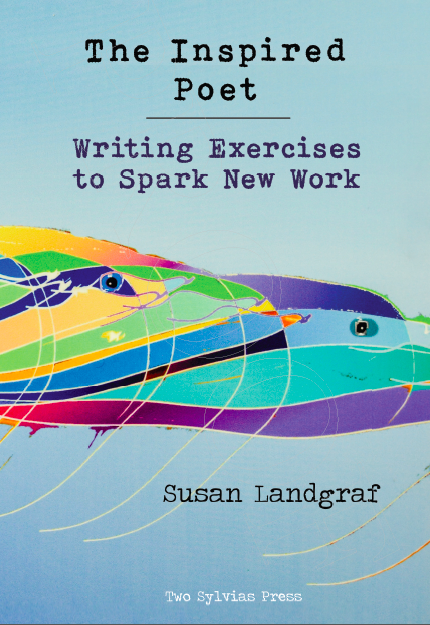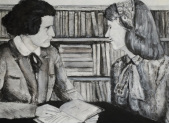Praise for The Inspired Poet: Writing Exercises to Spark New Work
An engaging and generous personal writing guide, sure to inform and inspire.
— Kim Addonizio, author of Ordinary Genius: A Guide for the Poet Within
One of the most difficult aspects of the writing life is simply getting started: quieting our internal critic long enough to create a first draft. With this diverse series of craft-focused, creative-writing exercises, Susan Landgraf offers the keys to unlock the writing inside us—and the fuel to inspire the writing that sustains us.
— Jordan Hartt, author of Leap and Drifting
Susan Landgraf is indeed paying attention, and with this collection of playful, engaged, provocative exercises, she makes us pay attention as well—to cages and bodies and blankness and song, to cream of wheat, letters to our feet, and apple slices under a virgin’s arms, and mostly to the poems waiting to be born inside, outside, and all around us.
— Sam Ligon, author of Among the Dead and Dreaming, Safe in Heaven Dead, Wonderland, and Drift and Swerve
Writers, your subconscious installs writer’s block into your wetware to rescue your work from a wrong turn. Your personal “keep writing” tricks can’t crack it. Remember when writing was more fun than frustration? Try other writers’ tricks to break your block and to bring fun back to your writing. Susan Landgraf’s The Inspired Poet offers breakthrough tools from, and for, writers of all genres. Writing is serious business, but never forget: Fun is good! Use it!
— Bill Ransom, author of The Woman and the War Baby and Jaguar
Sample Exercise:
Chapter 12: Writing Into Our Fears
We all have met fear in our lives. It’s a great motivator with two possibilities: flight or fight. Fear comes with many names: fear of success, fear of failure, fear of closed spaces, fear of open spaces, fear of loud noises, fear of spiders, dogs, drowning, or heights, just to name a few.
Think about any fears you might currently have, as well as any fears you have overcome.
Exercise 1: It Tastes Like Brussels Sprouts
Choose one of your fears, then answer the following questions (be as creative and inventive as you can):
—What is its shape?
—What sound does your fear make?
—What does that fear taste like in your mouth?
—Where does that fear go when you aren’t thinking about it?
—Where do you want it to go?
—What do you tell your fear? “Get lost.” “Have a life somewhere
else.” Or “I’ve buried you under the big rock at Needle Pass.
There were no witnesses.”
—What does fear tell you?
Write a poem about fear using your answers to the above questions. It might be relieving to get that fear out on the page where you and your readers can see it and react to it.
Sometimes fear is so personal it’s hard to write about. If you are having difficulty writing about your fear in the first person (“I”), try writing the poem from third person (he/she/they) in which you are observing yourself or the speaker struggling with this fear.
Consider using one of the following as an opening line, “When I saw fear, it said. . .” or “When fear arrived, it resembled a. . .”
Exercise 2: Bake An Anxiety Cake
Write a recipe poem using fear as your inspiration. Recipes use active verbs and are not filled with rhetoric. They’re didactic, to the point, with specific instructions:
Sauté 3 cloves garlic and 1 onion chopped in 1 tsp. of olive oil
Add 1 pound ground beef
Add 1 cup white rice
Add 1 can of diced tomatoes
Simmer for 10 minutes
Write a recipe poem about a specific fear in the form of a recipe. Think about what you’re going to do to get rid of this fear, what you would add, subtract, or mix in. You can use a recipe card format, but go outside the box in terms of ideas, phrases, etc.
For the title of your poem, look up the clinical name for your fear. If you’re afraid of open spaces, your poem could be called “Recipe to Reverse Agoraphobia” and include lines like:
Cut out pictures of open fields and parks from magazines and flyers.
Paste them in a scrapbook.
Practice keeping the draperies open for a half hour each day.
Ask my friend Alice to go with me to the park.
Wear sunglasses.
Pretend I’m someone else, maybe a dog.
Dogs love open spaces.
Repeat several times a day: Martians don’t like open spaces, but I do.
Consider writing several recipe poems using different fears as your inspiration.
Poems To Inspire Your Work:
(each exercise contains several example poems from published poets)
We all have met fear in our lives. It’s a great motivator with two possibilities: flight or fight. Fear comes with many names: fear of success, fear of failure, fear of closed spaces, fear of open spaces, fear of loud noises, fear of spiders, dogs, drowning, or heights, just to name a few.
Think about any fears you might currently have, as well as any fears you have overcome.
Exercise 1: It Tastes Like Brussels Sprouts
Choose one of your fears, then answer the following questions (be as creative and inventive as you can):
—What is its shape?
—What sound does your fear make?
—What does that fear taste like in your mouth?
—Where does that fear go when you aren’t thinking about it?
—Where do you want it to go?
—What do you tell your fear? “Get lost.” “Have a life somewhere
else.” Or “I’ve buried you under the big rock at Needle Pass.
There were no witnesses.”
—What does fear tell you?
Write a poem about fear using your answers to the above questions. It might be relieving to get that fear out on the page where you and your readers can see it and react to it.
Sometimes fear is so personal it’s hard to write about. If you are having difficulty writing about your fear in the first person (“I”), try writing the poem from third person (he/she/they) in which you are observing yourself or the speaker struggling with this fear.
Consider using one of the following as an opening line, “When I saw fear, it said. . .” or “When fear arrived, it resembled a. . .”
Exercise 2: Bake An Anxiety Cake
Write a recipe poem using fear as your inspiration. Recipes use active verbs and are not filled with rhetoric. They’re didactic, to the point, with specific instructions:
Sauté 3 cloves garlic and 1 onion chopped in 1 tsp. of olive oil
Add 1 pound ground beef
Add 1 cup white rice
Add 1 can of diced tomatoes
Simmer for 10 minutes
Write a recipe poem about a specific fear in the form of a recipe. Think about what you’re going to do to get rid of this fear, what you would add, subtract, or mix in. You can use a recipe card format, but go outside the box in terms of ideas, phrases, etc.
For the title of your poem, look up the clinical name for your fear. If you’re afraid of open spaces, your poem could be called “Recipe to Reverse Agoraphobia” and include lines like:
Cut out pictures of open fields and parks from magazines and flyers.
Paste them in a scrapbook.
Practice keeping the draperies open for a half hour each day.
Ask my friend Alice to go with me to the park.
Wear sunglasses.
Pretend I’m someone else, maybe a dog.
Dogs love open spaces.
Repeat several times a day: Martians don’t like open spaces, but I do.
Consider writing several recipe poems using different fears as your inspiration.
Poems To Inspire Your Work:
(each exercise contains several example poems from published poets)


